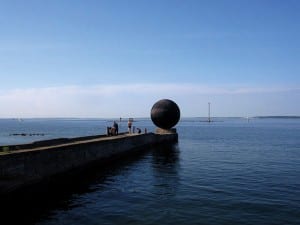“We are unwholly ourselves when we mark stark boundaries between our bodies and that of other non-human bodies of nature. To speak of nature as something that exists apart from us or something merely ‘outside’ is to deny our own creatureliness and our humanness. We are part of the environment.” These are the words of Nigerian-American writer and critic Enuma Okoro. Okoro curates Hauser & Wirth’s latest New York exhibition The Flesh of the Earth, a show that reimagines a “more intimate relationship with the earth.” It includes work by contemporary artists including Adama Delphine Fawundu, Olafur Eliasson, Jenny Smith and Lorna Simpson, alongside the poetry of Pushcart-nominated writer Ama Codjoe. Okoro implores us to renew our connection to the land, explaining: “We are part of the environment. We too are of the soil and the elements. There is so much transformative and necessary relational engagement between our beginnings and endings to which we have to return, and in some instances heal.” The resulting exhibition is a multidisciplinary display of film, painting, photography and sculpture.

Adama Dephine Fwundu’s distinct visual language is emblematised in the single-channel film Cosmic Echoes. The artist’s work is instinctual and mesmerising. We’re confronted with a figure who emerges from the waves in a flowing yellow dress. Audiences are taken on a sensory journey through verdant fields and rippling oceans, guided by a central character who rubs white chalk over her face. Born in Brooklyn to parents from Sierra Leone and Equatorial Guinea, Fwundu navigates multilayered African Indigenous beliefs, evoking wisdom in her visual storytelling. She sees all elements as intertwined and alive with “performative power” – a vital Yorùbá force understood as the source of all existence. Elsewhere, we see the artist’s photography such as the image Ngewo Whispers (2023). The artist occupies ghostly sites that bore witness to events of the African diaspora – in this case Savannah, Georgia. Here, the artist appears dressed in a bright blue dress and wearing cowries in her hair amidst a verdant setting. Her body acts a bridge between human and more-than-human worlds. It threads a connective strand of exchange between the generative, energetically active space of nature and the material structures of history.

Elsewhere, sculptures like Olafur Eliasson’s Now, here, nowhere (2023) explore the interrelationship between different bodies of the natural world. Gold, red-orange and blue-green circles layer on panels of coloured glass. They sit on a length of found driftwood from Iceland – its naturally weathered wood evoking reconsiderations of time and temporality. Like his Big Bang Fountain (2014), an installation that focused on the dynamism of liquid materials, for The Flesh of the Earth Eliasson focuses on how bodies of water move and carry other objects in their flow. The piece has an ellipses-like quality whilst also evoking phases of the moon, circadian rhythms and the effect of solar and lunar cycles on our behaviour. In context of the show, it pairs well with Kiki Smith’s Dark Water (2023), a plated bronze work that displays a figure emerging from water. Blue tentacle-like structures hold her above the ground, casting a heroine-like silhouette. Eliasson reveals washed up objects that emerge from the ocean as Smith conjures figures that rise from it. These are works that hold us, informing a larger exhibition that recognises our interdependence with the organic world. We come away reminded of a closing line from a poem by Ama Codjoe: “Look, there’s a blue / whale breaching. Come quick, the sun is diving into the sea.”
The Flesh of the Earth | Until 6 April
Image Credits:
© Adama Delphine Fawundu, Ngewo Whispers (2023). Courtesy the artist and Hesse Flatow, New York
© Adama Delphine Fawundu, Still from Cosmic Echoes (2023). Courtesy the artist and Hesse Flatow, New York
© Kiki Smith, Dark Water (2023). Courtesy the artist and Pace Gallery




